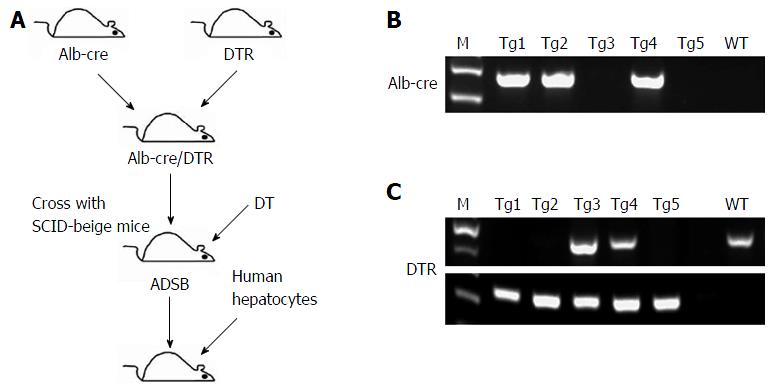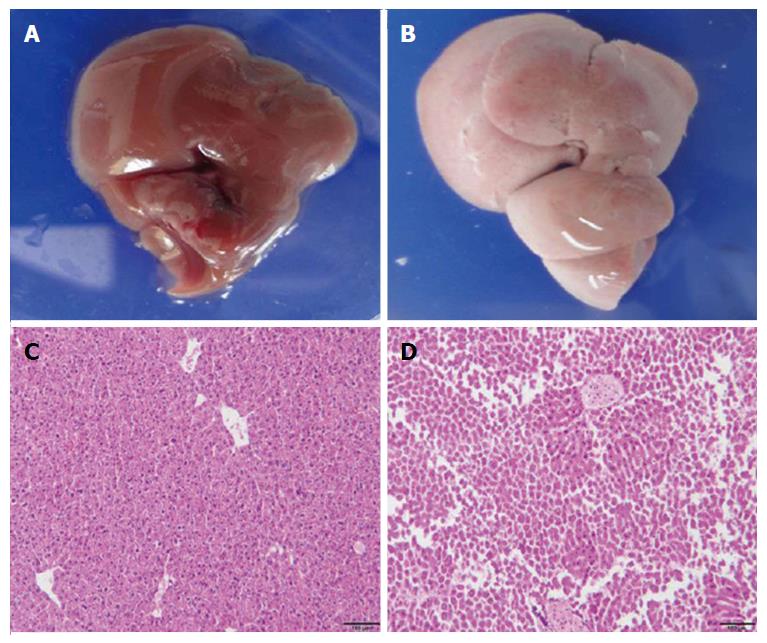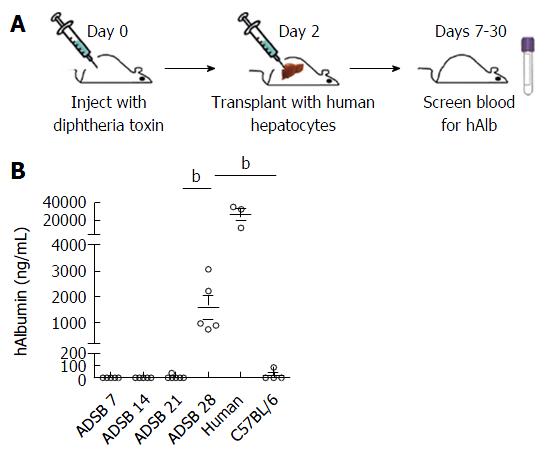Copyright
©The Author(s) 2017.
World J Gastroenterol. Jul 21, 2017; 23(27): 4935-4941
Published online Jul 21, 2017. doi: 10.3748/wjg.v23.i27.4935
Published online Jul 21, 2017. doi: 10.3748/wjg.v23.i27.4935
Figure 1 Experimental design and PCR analysis of Alb-cre/diphtheria toxin receptor transgenic mice.
A: Experimental design used to characterize DT liver injury in ADSB mice, which were used for human hepatocyte transplantation; B: PCR analysis of the Alb-cre gene, Tg1, Tg2 and Tg4 mice are cre-positive; C: PCR analysis of the DTR gene, Tg1, Tg2 and Tg5 are homozygous DTR mice, and Tg3 and Tg4 are heterozygous DTR mice. ADSB: Triple-crossed albumin (Alb)-cre transgenic mice, inducible diphtheria toxin receptor (DTR) transgenic mice and severe combined immune deficient-beige mice; DT: Diphtheria toxin.
Figure 2 Histological analysis of liver injury.
Two days after DT treatment, liver sections from non-transgenic mice and ADSB mice were stained with H and E. A: The liver from non-transgenic mice (C57BL/6); B: The liver from ADSB mouse; C: A representative liver section from non-transgenic mice showing normal histological appearance; D: A representative liver section from ADSB mice showing liver injury. ADSB: Triple-crossed albumin (Alb)-cre transgenic mice, inducible diphtheria toxin receptor (DTR) transgenic mice and severe combined immune deficient-beige mice; DT: Diphtheria toxin; H and E: Hematoxylin and eosin.
Figure 3 Body weight and alanine aminotransferase analysis after diphtheria toxin injection.
ADSB mice (filled circle) and non-transgenic mice (open circle) were injected with 2.5 ng/g bodyweight DT. A: The bodyweight change ratio in the two groups of mice after injection of DT; B: Analysis of serum ALT activity in the mice. Data are shown as the mean of each group, and error bars represent SD (n = 3); aP < 0.05, bP < 0.01, eP < 0.001. ADSB: Triple-crossed albumin (Alb)-cre transgenic mice, inducible diphtheria toxin receptor (DTR) transgenic mice and severe combined immune deficient-beige mice; ALT: Alanine aminotransferase; DT: Diphtheria toxin.
Figure 4 Human albumin plasma concentration in Alb-cre/DTR/SCID-beige mice after adult hepatocyte transplantation.
A: Schematic of liver humanization. Two days after the intraperitoneal injection of DT, serum was collected for ALT assay. Human hepatocytes were transplanted into these mice on the same day; B: Serum levels of human albumin are shown for ADSB mice (n = 5) on day 7, 14, 21 and 28 after hepatocyte transplantation as detected by enzyme-linked immunosorbent assay. Results are mean ± SEM (n ≥ 3); bP < 0.01. ADSB: Triple-crossed albumin (Alb)-cre transgenic mice, inducible diphtheria toxin receptor (DTR) transgenic mice and severe combined immune deficient-beige mice; ALT: Alanine aminotransferase; DT: Diphtheria toxin.
Figure 5 Human Kupffer cells in the liver of Alb-cre/DTR/SCID-beige mice.
Human Kupffer cells stained with CD68, showing the high degree of liver chimerism. A: Non-transplanted C57BL/6 mice; B: ADSB mice 4 wk after transplantation; C: ADSB mice 12 wk after transplantation. Red arrows exhibit positive staining. Scale bar = 50 μm, × 400. ADSB: Triple-crossed albumin (Alb)-cre transgenic mice, inducible diphtheria toxin receptor (DTR) transgenic mice and severe combined immune deficient-beige mice.
- Citation: Ren XN, Ren RR, Yang H, Qin BY, Peng XH, Chen LX, Li S, Yuan MJ, Wang C, Zhou XH. Human liver chimeric mouse model based on diphtheria toxin-induced liver injury. World J Gastroenterol 2017; 23(27): 4935-4941
- URL: https://www.wjgnet.com/1007-9327/full/v23/i27/4935.htm
- DOI: https://dx.doi.org/10.3748/wjg.v23.i27.4935













